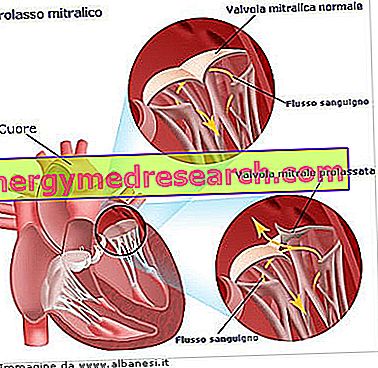Generality
Angiomyolipoma is a benign tumor typical of the kidney, part of the neoplastic category of PEComi and hamartomas.

The angiomyolipoma of the kidney tends to be asymptomatic as long as its size is less than 4 centimeters; starting from larger sizes, it can instead cause retroperitoneal hemorrhage, severe abdominal pain, hematuria, recurrent urinary tract infections and hypertension.
The diagnosis of angiomyolipoma is based on radiologic examinations related to the abdomen.
The presence of an angiomyolipoma requires therapy only when its size is over 4 centimeters or when it is symptomatic.
Brief anatomical and functional recall of the kidneys
In number of two, the kidneys are the organs which, together with the urinary tract, constitute the so-called urinary tract or excretory apparatus, whose task is to produce and eliminate urine.
Representing the main structures of the aforementioned apparatus, the kidneys reside in the abdominal cavity - to be precise on the sides of the last thoracic vertebrae and the first lumbar vertebrae - they are symmetrical and possess a shape very similar to that of a bean.
FUNCTION OF THE KIDNEYS
The kidneys hold various functions; among these, the most important are:
- Filter the waste substances, along with the harmful or foreign substances present in the blood, and convert them into urine;
- Adjust the hydro-saline balance of blood;
- Adjust the acid-base balance of blood.
As readers will have noticed, kidney functions are closely related to blood; the latter comes from the kidneys from the renal artery and returns to the venous system through the renal vein, which then flows into the so-called vena cava .
What is angiomyolipoma
Angiomyolipoma is a benign tumor that almost always affects the kidney and typically involves three cellular components: a component of vascular cells (angio), a component of immature smooth muscle cells (-my-) and a cell component lipidic (-lipoma).
Given the frequent renal involvement in angiomyolipoma cases, starting from the chapter dedicated to the causes onwards, this article will focus specifically on angiomyolipoma of the kidney.
What is a benign tumor?
A tumor is an abnormal mass of very active cells, whose rhythm of growth and division borders on the abnormality.
A tumor is defined as benign when, despite the high rate of growth and division, it is not infiltrative towards the surrounding tissues and organs (ie it does not invade neighboring tissues and organs) and does not enjoy any metastasizing power (ie it is not in able to disseminate its cancer cells elsewhere).
In which tumor category does angiomyolipoma appear?
At one time, the medical-scientific community brought angiomyolipoma back into the tumoral category of hamartomas ; hamartomas are benign tumor formations, whose cells, despite the anomalous proliferation of which they have become protagonists, maintain the same original structural characteristics (in general, the cells of a tumor take on totally different connotations from those they originally had, when growth and replication were still normal).
Today, however, experts believe it is more appropriate to include angiomyolipoma in the tumor category of PEComes or tumors (-omas) of Perivascular Epithelioid Cells (PEC); a PEComa is a particular type of mesenchymal tumor, which can form in any part of the body and is made up of atypical cells - the so-called perivascular epithelioid cells - without a healthy equivalent.
Renal angiomyolipoma
Angiomyolipoma of the kidney is more properly known as renal angiomyolipoma .
Representing the most widespread benign-type kidney tumor, renal angiomyolipoma is, in 80% of clinical cases, a sporadic phenomenon and, in the remaining 20%, a phenomenon associated with a genetic disease called tuberous sclerosis .
As a sporadic event, angiomyolipoma affects mainly female adults over the age of 40; on the contrary, as an event associated with tuberous sclerosis, it particularly affects young people around 10 years of age, without any distinction of sex.
Another important difference between sporadic renal angiomyolipoma and renal angiomyolipoma associated with tuberous sclerosis is the fact that, while the former usually affects a kidney only and in single mode, the latter tends to involve both the kidneys and in multiple mode.
What other organs can develop angiomyolipomas?
Although very rarely, angiomyolipomas can form in organs and anatomical structures different from the two kidneys, including: the liver, the ovaries, the fallopian tubes, the spermatic cord, the palate and the colon.
Causes
Scientific studies have shown that the formation of a renal angiomyolipoma (both the sporadic version and that associated with tuberous sclerosis) is due to the mutation of the TSC1 or TSC2 genes . Located respectively on chromosome 9 and on chromosome 16, TSC1 and TSC2 produce (obviously under normal conditions) proteins that, acting together, suppress all those anomalous mechanisms that lead to the formation of tumors.
What causes TSC1 and TSC2 mutations?
If in the case of renal angiomyolipoma associated with tuberous sclerosis the mutations against TSC1 and TSC2 are linked to the genetic aberrations of the tuberous sclerosis itself (so it is possible to recognize in the latter the cause of the benign kidney tumor), in the case of sporadic renal angiomyolipoma mutational events affecting the same genes have a completely unknown origin.
Symptoms and complications
In the presence of a renal angiomyolipoma, the presence of symptoms is strictly dependent on the size of the tumor mass; renal angiomyolipomas of small diameter, in fact, are generally asymptomatic, while renal angiomyolipomas of considerable diameter are responsible for different consequences and various symptoms and signs.
Generally, an angiomyolipoma begins to be symptomatic when its diameter exceeds 4 centimeters .
In the kidney, angiomyolipomas usually form at the level of the so-called renal cortex .
Large angiomyolipoma symptomatology
The symptoms and consequences that can derive from a large renal angiomyolipoma consist of:
- Retroperitoneal hemorrhage, followed by severe abdominal pain . The haemorrhagic phenomena are due to the lesion of one or more blood vessels constituting the tumor mass.
The abdominal pains that follow a retroperitoneal hemorrhage are sudden (therefore it is impossible not to notice) and associated, very often, to episodes of nausea and vomiting ;
- Abdominal level presence of a palpable mass . This mass is nothing but renal angiomyolipoma;
- Recurrent urinary infections
- Hematuria ;
- Hypertension .
Complications of renal angiomyolipoma
Although it is a benign tumor, renal angiomyolipoma can have serious repercussions on human health; in fact, when it is large and in multiple versions (as in the case of tuberous sclerosis), its presence can lead to the development, by the patient, of a condition of renal failure .
Furthermore, it is important to remind readers that severe retroperitoneal bleeding and retroperitoneal haemorrhages that are not treated promptly can lead to shock and cause the death of the individual concerned.
When should I go to the doctor?
The episodes of retroperitoneal hemorrhage that can capture the carriers of a renal angiomyolipoma represent medical emergencies, therefore they deserve immediate treatment.
As mentioned, the unequivocal symptom of the aforementioned episodes in the presence of which it is necessary to contact a doctor or go to the nearest hospital is a strong and sudden pain in the abdomen.
Diagnosis
The diagnosis of angiomyolipoma is based on three diagnostic imaging tests, which are: abdominal ultrasonography, nuclear magnetic resonance of the abdomen and abdominal CT scan.
Diagnostic relevance of the lipid component
The lipid component of renal angiomyolipoma is very important for diagnostic purposes, as its presence makes it possible to distinguish the aforementioned benign renal tumor from renal adenocarcinoma, a serious malignant tumor of the kidney.
The above is the reason why, when a renal angiomyolipoma has a reduced lipid cellular component, its distinction from renal adenocarcinoma is decidedly more complex and requires the use of more in-depth diagnostic tests.
| Table. Advantages and disadvantages of ultrasound, nuclear magnetic resonance and CT scans. | ||
| Diagnostic examination | Advantages | Disadvantages |
Abdominal ultrasound | It is a minimally invasive examination. It allows to identify the lipid cell component (important for distinguishing renal angiomyolipoma from a malignant kidney tumor). It is a quick and inexpensive test. | It does not allow to accurately assess the non-lipid cellular components of renal angiomyolipoma. |
Nuclear magnetic resonance of the abdomen | Does not expose the patient to harmful radiation. Provides clear and detailed images of angiomyolipoma. | It is a long examination. |
Abdominal CT scan | It is perhaps the exam that provides the clearest and most detailed images. It's quick | It exposes the patient to a negligible dose of harmful ionizing radiation. |
Search for triggering causes: what does it require?
Once the presence of a renal angiomyolipoma has been established, the diagnostic doctor is required to investigate with a series of tests (objective examination, medical history, ophthalmological examination, genetic counseling, etc.), if the tumor in question is a sporadic phenomenon or depends on sclerosis tuberose.
Surely, among the elements that suggest the presence of tuberous sclerosis, they deserve a quotation:
- The young age of the patient (tuberous sclerosis causes juvenile forms of renal angiomyolipoma);
- Involvement of both kidneys;
- The multiple aspect of renal angiomyolipoma.
Therapy
Angiomyolipoma requires therapy only when its size exceeds 4 centimeters in diameter or when it is a symptomatic condition. Therefore, as long as it is small and remains asymptomatic, it does not recall the attention of doctors, except as regards its periodic monitoring.
When required, angiomyolipoma therapy is solely and exclusively surgical.
Deepening on surgical therapy
There are two surgical treatments available today for the treatment of renal angiomyolipoma : the so-called embolization and partial nephrectomy .
Embolization consists of filling the blood vessels of the tumor mass with artificial emboli, in such a way as to block the internal blood flow and reduce the risk of haemorrhagic phenomena.
The intervention of partial nephrectomy, instead, consists substantially in the removal of the portion of kidney in which the tumor resides.
As can be deduced from the descriptions of the two therapeutic approaches, embolization is a less invasive treatment than partial nephrectomy, but - unlike the latter - does not involve the elimination of angiomyolipoma.
The choice to opt for embolization or partial nephrectomy is the responsibility of the attending physician and depends on various factors, including: the precise size of the tumor, the site of the tumor mass and the risk of complications.
Prognosis
The prognosis in case of renal angiomyolipoma depends on:
- The size of the benign tumor. A large renal angiomyolipoma presents a greater risk of complications and is more likely to cause patient death due to retroperitoneal hemorrhage.
- The triggering cause. The episodes of renal angiomyolipoma due to tuberous sclerosis have a worse prognosis.



